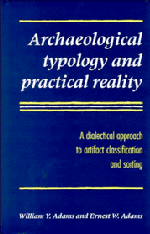 Archaeological Typology and Practical Reality
Archaeological Typology and Practical Reality Published online by Cambridge University Press: 23 November 2009
Before concluding the practical section of our work, it seems desirable to synthesize the main ideas that have been expressed in earlier chapters into a set of general principles, which we will call “principles of practical typology.” For convenience they will be subdivided into basic principles, principles of type formulation, principles of practicality, and principles of utility.
Basic principles
A type, as defined in this work, is at once a group of entities, our ideas about those entities, and the words and/or pictures in which we represent our ideas. In other words a type in the fullest sense has material, mental, and representational dimensions (Chapter 3).
The relationship between the material, mental, and representational dimensions of typehood is mutable. Either the objects, our ideas about them, or the ways in which we represent the ideas may change, without necessarily effecting change in the other dimensions (Chapter 3).
Types have the two essential properties of identity and meaning. That is, to be useful they have to be consistently identifiable, and they have in addition to tell us something that we want to know (Chapter 3).
Individual type concepts can originate in various ways, by intuition or by some process of conscious analysis. Once they have come into being, type concepts generally evolve as we apply them to actual entities, through a continuous feedback between our observations of the objects and our ideas about them.
To save this book to your Kindle, first ensure [email protected] is added to your Approved Personal Document E-mail List under your Personal Document Settings on the Manage Your Content and Devices page of your Amazon account. Then enter the ‘name’ part of your Kindle email address below. Find out more about saving to your Kindle.
Note you can select to save to either the @free.kindle.com or @kindle.com variations. ‘@free.kindle.com’ emails are free but can only be saved to your device when it is connected to wi-fi. ‘@kindle.com’ emails can be delivered even when you are not connected to wi-fi, but note that service fees apply.
Find out more about the Kindle Personal Document Service.
To save content items to your account, please confirm that you agree to abide by our usage policies. If this is the first time you use this feature, you will be asked to authorise Cambridge Core to connect with your account. Find out more about saving content to Dropbox.
To save content items to your account, please confirm that you agree to abide by our usage policies. If this is the first time you use this feature, you will be asked to authorise Cambridge Core to connect with your account. Find out more about saving content to Google Drive.